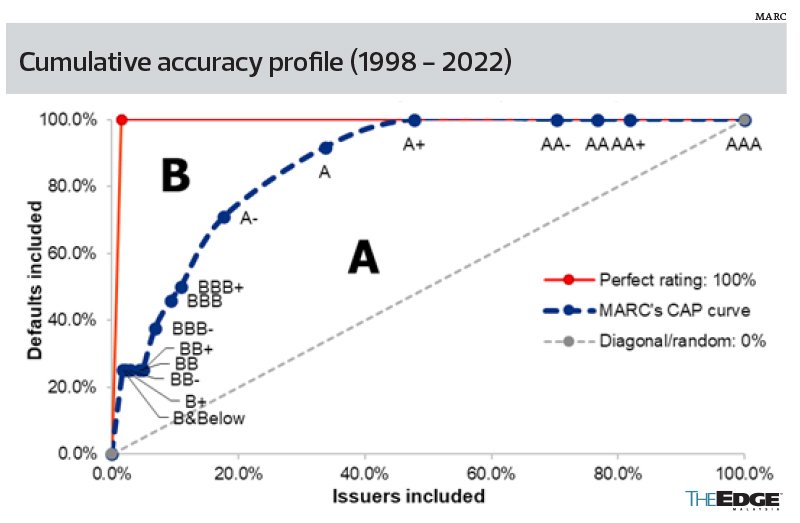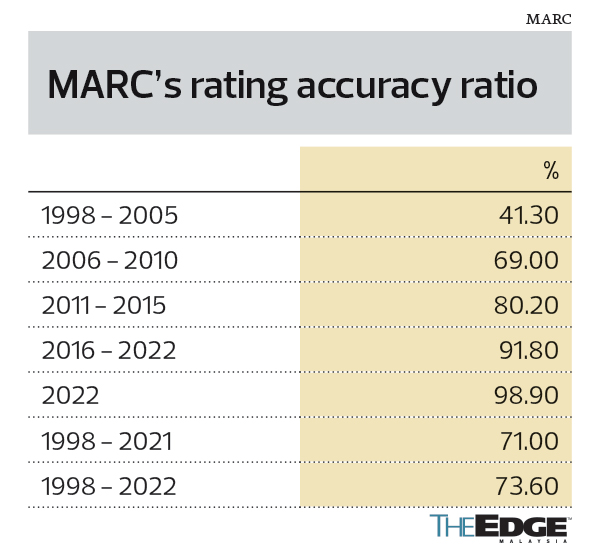This article first appeared in The Edge Malaysia Weekly on May 8, 2023 - May 14, 2023
THE issuance of new guidelines by the Securities Commission Malaysia (SC) for credit rating agencies (CRA) in January this year was seen by many as the capital market regulator’s response to concerns over potential shareholder domination at the agencies.
This followed its approval for CTOS Digital Bhd last April to increase its shareholding in RAM Holdings Bhd beyond the 20% threshold, to more than 51%.
Under the SC’s revised CRA guidelines, the definition of the controller was given better clarity — an entity or person with not less than 15% ownership, among other criteria — and brought in line with the Capital Markets and Services Act 2007.
For Datuk Jamaludin Nasir, CEO of Malaysian Rating Corp Bhd (MARC), the extension of the new guidelines to cover the holding company and controllers of CRAs has been the most significant change.
Previously, in the early days when credit rating agencies came under the purview of Bank Negara Malaysia, he notes that the shareholding in a CRA was capped at less than 5% each, creating highly fragmented ownership.
Furthermore, as this was not a large enough block, shareholders had no obligation to contribute to the growth and credibility of the CRA.
“Irrespective of the controlling or significant shareholding held by an entity, it is paramount that CRAs remain independent, objective and transparent without any undue influence in their rating analysis and decision,” Jamaludin says in a recent interview with The Edge.
For MARC, which was set up in 1996, its top two shareholders are Moody’s Asia Pacific Ltd and CARE Ratings Ltd with a stake of over 19% and 10% respectively.
According to Jamaludin, the two shareholders would be required to obtain the SC’s approval should they want to increase their present shareholding beyond the prescribed threshold.
He says while MARC has support from its shareholders, it has grown its CRA business optimally on its own.
Notably, MARC has undergone tremendous changes in the past two decades, with the most recent being the transformation of the group into a finance services investment holding company with four subsidiaries, namely MARC Ratings Bhd, MARC Data Sdn Bhd, MARC Solutions Sdn Bhd and MARC Learning Sdn Bhd.
“Since embarking on its strategic move to enlarge its product offerings across different markets, MARC will deepen its knowledge with a need for significant support from its stakeholders and collaboration with key partners to realise its visions,” says Jamaludin.
It is worth noting that the CRA guidelines, first issued in 2011, have been revised three times as government securities gross issuance rose from RM58.1 billion in 2010 to RM171.5 billion in 2022. Corporate bonds rose from RM53 billion to RM153 billion during the same period.
“Rating agencies in Malaysia today monitor a sizeable amount of issuance. If you look at the capital market today, we have RM1.6 trillion to RM1.7 trillion outstanding, including MGS (Malaysian Government Securities) and GII (Government Investment Issues). MGS and GII issuance amounting to about RM1 trillion is big compared to the overall capital market,” Jamaludin points out.
The regulator has also implemented better measures to ensure that the boards of directors of the rating agencies are independent and free from conflicts of interest. This is to ensure that the rating agencies remain objective and impartial in their decisions.
Jamaludin notes that, at MARC, its Management Rating Committee (MRC) is chaired by the chief rating officer (CRO), with members comprising portfolio heads, senior analysts and economists.
“The MRC plays a key role in ensuring that our analysis is deep and follows our methodology and that the qualitative and quantitative scoring is reflective of the rated company’s strengths and the proposed issuance,” he says.
Based on the CRA guidelines, the Rating Committee is chaired by an external independent member. Most of the members are independent, usually former analysts, former bankers, or former fund or portfolio managers.
MARC, one of two CRAs in Malaysia, the other being RAM, achieved a rating accuracy ratio of 73.6% between 1998 and 2022, with 950 rating assignments on outstanding debt issuance worth RM1 trillion over the span of 27 years.
MARC may have achieved the RM1 trillion milestone, but it is still imperative for the agency to remain vigilant in order to protect investors and maintain its credibility in the industry.
“In MARC, we carry out stress tests. Usually, in a stress test, the scenarios are largely on swings or aberrations on normalised market events.
“Our assessments not only consider the qualitative and quantitative aspects in the analysis but also reflect the potential impact of an operating environment and external factors such as quality of regulations and supervisions for the case of banks,” says Jamaludin.
One of MARC’s rating assignments in the past included that on Serba Dinamik Holdings Bhd’s credit facility. A month before the latter defaulted on its debt, MARC raised red flags on its Islamic medium-term note (IMTN) and Islamic commercial paper (ICP) programmes. (MARC is not involved in any legal proceedings against Serba Dinamik).
The events that led to its downgrade to a default rating of Serba Dinamik’s facilities, however, remain clear. Jamaludin declined to comment due to legal proceedings against the company, which is being liquidated.
To assess its ratings accuracy ratio, Jamaludin says MARC primarily uses the cumulative accuracy profile (CAP) and its summary statistics. CAP is a widely adopted international credit ratings system that is designed to provide an accurate assessment of credit ratings. It is used to measure the rate of correct predictions of credit ratings compared to the total number of predictions (see graph).
Despite there being only two local rating agencies in Malaysia, Jamaludin says the duo have always operated independently.
“There are people who are worried we (MARC and RAM) would gang up and become a duopoly. This has not been the case.
“I am a believer that at the end of the day, rating agencies play a vital role in the fundraising exercise in the capital market. We need to recruit and retain capable and talented analysts because of the significance of our role to ensure continued market confidence in the Malaysian capital market.”
Yet, globally, CRAs are still viewed with a healthy dose of scepticism, especially when considering the status of too-big-to-fail global systemically important banks (G-SIBs).
This was evident in the case of Credit Suisse. The Swiss Financial Market Supervisory Authority decided to write off CHF16 billion (US$17.5 billion or RM78 billion) of Credit Suisse’s Additional Tier 1 or AT1 debt to zero as part of the bank’s forced rescue merger with UBS.
Under the deal, holders of Credit Suisse AT1 bonds will get nothing, while shareholders, who usually rank below bondholders in terms of who gets paid when a bank or company collapses, will receive US$3.23 billion.
To this point, Jamaludin says if the regulatory framework is “ill-fitting”, it can constrain the debt capital market’s growth and resiliency. “It could also hinder the proper functioning of debt capital markets by, for example, excessively incentivising risk-taking when times are good.
“So debt capital market can still contribute to the economy during challenging times, but only when it is well regulated to ensure proper functioning of its intended purpose.”
He believes AT1 bonds are still a viable funding source for banks, including in Malaysia, owing to the competitive cost of capital.
Meanwhile, MARC expects some RM100 billion to RM120 billion worth of new debt issuances in Malaysia this year, with about 40% coming from banks and/or financial institutions.
“Given the anticipated moderating economic growth and investment, along with tighter financial conditions resulting from Bank Negara’s four consecutive 25-basis-point OPR (overnight policy rate) hikes last year, we expect this year’s issuance of local long-term corporate bonds to normalise (between RM100 billion and RM120 billion),” says Jamaludin.
Save by subscribing to us for your print and/or digital copy.
P/S: The Edge is also available on Apple's App Store and Android's Google Play.
- Tariff shock awaits China after trade surplus hits US$103 bil
- Malaysian semiconductor stocks fall amid US probes, software firms steady
- HRD Corp's chief executive Shahul Hameed steps down, confirming The Edge report
- Autopart distributor MSB Global slips 15% on ACE Market debut
- US steps up probes into pharmaceutical, chip imports, setting stage for tariffs
- My Say: PGU still key to powering industrial growth despite gas explosion at Putra Heights
- Xi’s visit may unlock new investment opportunities beyond trade, says CGS International
- Farewell, Pak Lah
- EDGE WEEKLY: Straits Trading’s big Butterworth bet
- Mah Sing’s M Legasi township in Semenyih sees over 90% take-up for first phase of landed homes






